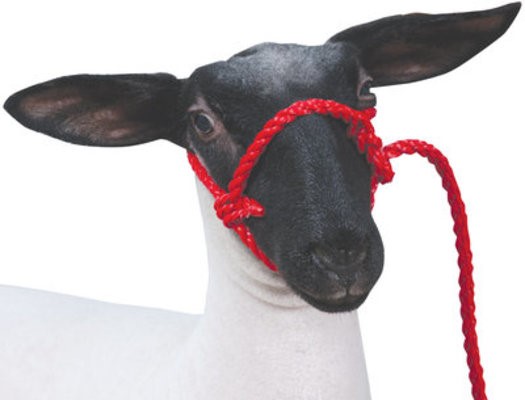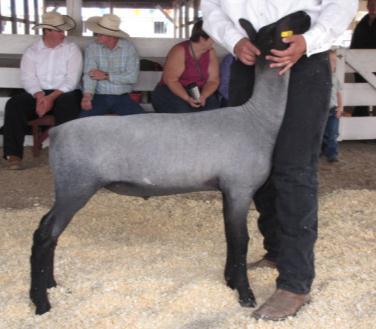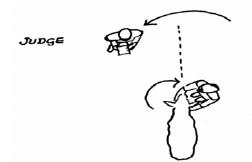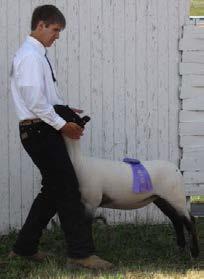Sheep Showmanship
SHEEP SHOWMANSHIP
All good showmen start training and preparing for show early and build a bond with their sheep. The key to show ring success is to present your animal as effectively as possible. A good showman will always make his or her animal look the best it can. Remember you are trying to promote the sheep industry as well as yourself, your family, your club and 4-H.
 Proper placement of a rope halter
Proper placement of a rope halter
Grooming Sheep and Lambs
Trim the feet so they stand correctly. Keep them trimmed. Trim the feet at least 7 days before showing (polish on feet is optional).
Shear market lambs at county weigh in. Slick shearing of market lamb is recommended 1 - 10 days before the show.
Use a damp cloth to wash the inside of the ears. Do not get water in the ears.
Shorn market lambs may be washed with mild soap but should be done far enough ahead of the show to allow the natural lanolin to return to the fleece. (Do not forget the foreflank and rearflank.) Smooth the shear marks, clip and blend in the legs, ears, and other parts of the body.
The wool breeds (Targhee, Rambouillet, and Columbia) are usually never washed. The mutton breeds may be washed, but far enough ahead of the show to allow the natural lanolin to return. Wool breed breeding sheep are shown unshorn. Mutton breeds may be shown shorn or unshorn.
Avoid a brushed appearance over the fleece. Dampen the fleece before trimming. Clean the feed, hay, burs, dung-locks and sweat-locks out of the fleece. Clip them as a last resort or blow them free from the wool. Do not color the wool.
Trimming the sheep fleece means pulling up the wool fibers with a wool card, then clipping them smoothly to the body contour with sheep shears. A good job requires several repeats. The more time you spend on it, the better the job. A gunny sack or canvas blanket will keep the fleece clean until show time and help bring out the lanolin. Tie it on snugly, not tightly, with cotton twine.
Preparation Immediately Before the Show:
- Clean the feet. Wash if necessary.
- Clean bedding from the fleece (especially underneath)
- Check the dock and hindquarters for cleanliness.
- Sheep should be clean, but not wet. A judge wants to handle a clean, dry animal. (exception on hot days a damp sheep is acceptable to most judges.
- Wipe the eyes and muzzle clean.
- Clean inside the ears.
Showing Sheep
Equipment: Exhibitor may carry a cloth to keep nose and face clean or a brush, but it is not required. Halters may be used at the discretion of department superintendents.
Showing Procedures
- Bring the sheep into the ring slowly in a clockwise direction, keeping a nice constant speed. Never enter the ring with a blanket on your sheep.
- When leading your lamb, you should be on the lamb’s left side; the lamb should be on your right. However, the judge may position themselves such that the exhibitor may need to change sides and lead from the right side so that sheep is between the exhibitor and the judge.
- Hold your animal with your left hand under the jaw. Ideally you should not have to use your right hand when showing; however, it may be placed on the dock in order to urge the lamb on. You may also use your right behind the head of your lamb to give you more control but do not keep your hand behind your back as you lead.
- Do not crowd your sheep in line. Leave plenty of room (at least a sheep’s length) between you and the next exhibitor. Move into position and set up your sheep. Always line up with the first animal in line.
- Always keep your lamb between you and the judge. Make sure you watch the judge closely so you can follow his/her directions accurately.
- Use the whole ring (or the portion of the ring indicated by the judge). Do not cut corners.
SETTING YOUR ANIMAL:
- When directed to stop in the ring or when you are placed in the lineup, your lamb should have all legs placed square underneath of them. Your sheep should be set up on level ground or the front feet on a slightly higher ground.
- Always set the legs closest to the judge first.
- Front feet may be placed by grasping the front leg at the knee or above and setting the leg where you want it or by lifting the animal up slightly and setting it down again.
- You may set the hind feet by reaching over the top of the animal or under the animal with your right hand and grabbing the leg above the hock with your free hand and positioning the leg into the intended spot. Smaller exhibitors may not be able to reach and in this case, the use of a boot may be helpful. Also, if the back legs need to be move backward, simply pushing into the lamb’s chest with one knee may cause the animal to put the foot into place.
 Proper lamb set-up and bracing.
Proper lamb set-up and bracing.
POSING WITH YOUR ANIMAL:
- After your animal is set up, position yourself at the head of the lamb and a little
to the left side. You may stand or squat with both feet squarely on the ground. Make sure to keep your lamb’s head up and the topline straight.
- If you choose to squat, do not put your knee on the ground.
- While your lamb is set up and the judge is appraising your animal, he or she may walk around your lamb. It is important that you are aware the judge is coming. If the judge comes from the right side of your animal around the front of the animal’s head, you should be on the left side of the animal. When the judge comes even with you, take three steps and pivot to the other side of the lamb. Now you are standing on the right side of the lamb and the judge is on the left.
- If the judge stops directly in front of your animal, DO NOT change sides until he/she commits to a side. When changing side, move slowly but deliberately.
 Movement of exhibitor from one side of the animal to the other when judge circles
Movement of exhibitor from one side of the animal to the other when judge circles
- REAR VEIW: When the judge is getting a rear view of your animal you may want to set the hind feet slightly wider than the front feet to make your sheep appear wider. Stand or squat on the side opposite of the judge with one or two hands under the jaw. You my place your other hand behind the sheep’s ears. Do not place your hand at any other place on the sheep such as over the shoulder or neck.
- FRONT VIEW: When the judge is getting a front view of your animal you will want to stand to the side of your lamb to give the judge an unobstructed view of your lamb. Never change sides when the judge is directly in front of you. Make sure your lamb’s head is high and it looks alert. It is more important to make sure the front feet are set than the hind feet.
- BRACING A LAMB: When the judge approaches the rear of sheep to handle it, you will want your sheep
to tighten up or “brace” and continue to brace until the judge is done handling the
sheep. You should be standing up in front of your lamb so the judge can get a full
view of your animal. Hold the sheep with both hands on either side of the jaw.
- There are several ways to brace your lamb. One way is to put a little pressure under the jaw and at the same time pull the head down slightly. A second method is to place your knee against the sheep’s chest or girth and pull the head up with both hands. Both methods cause the sheep to push forward and tighten up. Most showman use a combination of these methods. Find a way that works best for you.
- Striking your lamb in the hind end in attempt to make the sheep feel firmer is prohibited. Lifting the sheep’s front feet off the ground to brace is prohibited.
 Proper lamb set-up and bracing
Proper lamb set-up and bracing
MOVING YOUR LAMB TO ANOTHER PLACE IN LINE: When asked to move your lamb to another place in line, you may lead your animal
forward, turn your lamb to the right and come back through the spot exited, turn again
and lead into the position designated by the judge, or lead to the end of the line
and into the designated place, depending on how large the class is.
- General Guidelines:
- Always repair disturbed fleece after the judge touches your animal. Do this after the judge has finished touching your animal and has moved away from the animal.
- The judge may ask to see the teeth of your animal. To show the teeth, separate the lips to expose the teeth with your fingers.
- If the judge signals for animals in front of you to move to another line, move your animal forward to fill in the hole.
- Always keep your animal square in line with the first animal in line.
- Never place your hand on the lamb’s back or base of the neck.
- Never move or lift your lamb by grasping the wool.
- Do not block the judges’ view of your sheep.
- You should NEVER step over your sheep or go behind your animal when changing sides.
- To turn an animal, keep your hand on the jaw, not the throat, and turn its head towards your belt bucket. Slowly move the sheep towards you, switch hands until you stand at the opposite shoulder.
- Do not take advantage of other exhibitors by pulling into line ahead of someone else or having your sheep out of line so the judge cannot see others.
- Be prepared to answer questions about your animal and the sheep industry.
- Refer to all other General Showmanship Guidelines on pages 1-3 and your county or show rules.
